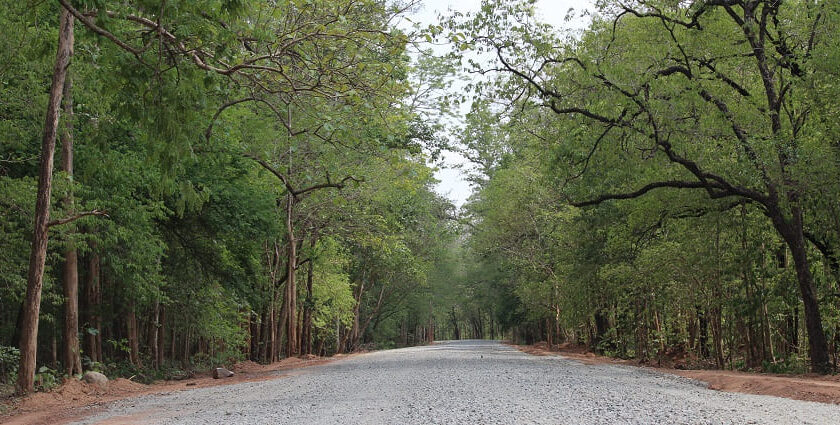Nestled in the heart of Chhattisgarh, India, Sitanadi Wildlife Sanctuary is a pristine heaven for all nature lovers and wildlife admirers. With the lushness of its landscapes and a varied ecosystem, Sanctuary is all set to take one on an escapist trip into the wild. The various Sitanadi Wildlife Sanctuary activities that one can engage in here range from wildlife safaris to nature walks, which would give an upfront view of the sanctuary’s rich biodiversity. Sitanadi is a life-enriching experience that treats you to the natural beauty and wildlife of the beautiful region.
Location
Photo: Bdmshiva / Wikimedia Commons
Sitanadi Wildlife Sanctuary’s address is located in the Dhamtari district of the state of Chhattisgarh, India. Sitanadi Wildlife Sanctuary is 100 kilometres from the state capital, Raipur. It is situated near the Sitanadi River, thus creating a wonderful scenic background from which to enjoy the wild and natural surroundings. The Sitanadi Wildlife Sanctuary contact number is very important when arranging any safari or guided tours. Its location makes it a serene getaway into nature, away from the hustle-bustle of urban life.
How To Reach Sitanadi Wildlife Sanctuary
Photo: Biswarup Ganguly / Wikimedia Commons / Image For Representation Only
By Road: The roads connecting this sanctuary are good, and you can drive from Raipur. It takes almost two hours to travel.
By Train: The nearest railway station is available at Dhamtari. From here, you can either hire a taxi or board a local bus to reach the sanctuary.
By Air: The nearest airport is Raipur. You can reach the sanctuary from the airport by taking a taxi or bus.
Places To Visit Near Sitanadi Wildlife Sanctuary
Here is a list of some places to visit near while exploring the Sitanadi Wildlife Sanctuary:
1. Barnawapara Wildlife Sanctuary
Photo: Davidvraju / Wikimedia Commons / Image For Representation Only
Located about 70 kilometres from Sitanadi Wildlife Sanctuary, Barnawapara Wildlife Sanctuary forms a very interesting destination for nature lovers. This protected area has a variety of flora and fauna and presents a kaleidoscopic contrasting difference to the experiences provided at Sitanadi for its wildlife. Food Web Diagram, besides leopards. Barnawapara sanctuary is quite near to Sitanadi and hence easily accessible, as well as an enriching addition to any visit to the region.
Entry Fees: ₹100
Location: 70 km from Sitanadi Wildlife Sanctuary
Best Time To Visit: November to March
2. Rajim
Photo: Ms Sarah Welch / Wikimedia Commons
Lying about 40 km away from Sitanadi Wildlife Sanctuary, Rajim is a historic town with a plethora of historical and cultural value. Famed for ancient temples and local festivals, Rajim presents a very interesting cultural contrast to nature at Sitanadi. The temples of the town, like Rajim Laxman Temple, speak volumes of the rich architectural heritage of the area. A tour to Rajim provides a clearer glimpse into the cultural topography of Chhattisgarh.
Location: 40 km from Sitanadi Wildlife Sanctuary
Best Time To Visit: November to February
3. Chitrakote Waterfalls
Photo: Ankit 8466 / Wikimedia Commons
Chitrakote Waterfalls, lying about 100 km away from Sitanadi Wildlife Sanctuary, also calls itself the ‘Niagara of India’. The large, beautiful waterfall adds a touch of drama to your tour in this area. The powerful cascading water and surrounding landscape establish a backdrop so picturesque that the scene offers a feast to the eyes and is incomparable with the serene environs of Sitanadi.
Entry Fees: ₹ 10 (per person)
Location: 100 km from Sitanadi Wildlife Sanctuary
Best Time To Visit: July to March
4. Sirpur
Photo: Ms Sarah Welch / Wikimedia Commons
Approximately 90 km away from the Sitanadi Wildlife Sanctuary, Sirpur is an important archaeological site comprising ancient ruins and temples. Historical remains provide a backlog of your visit to remnants of the ancient civilization that once thrived in the region. The temples and Buddhist remains of Sirpur offer a rich cultural and historical standing, making it an exciting counterpart to Sitanadi’s natural wonders.
Entry Fees: ₹ 10 per head
Location: 90 km from Sitanadi Wildlife Sanctuary
Best Time To Visit: November to March
Things To Do At Sitanadi Wildlife Sanctuary
1. Wildlife Safaris
Photo: Dushyant Kaushik / Wikimedia Commons
One of the major things to do while visiting Sitanadi Wildlife Sanctuary is going on a wildlife safari. These safaris offer an opportunity to witness the different fauna of the sanctuary in its natural environment: deer, leopard, and forms of birds. The best time for safaris is very early in the morning and late in the afternoon of the day since this is when most of the wild animals become active.
2. Bird Watching
Photo: Dibyendu Ash / Wikimedia Commons / Image For Representation Only
Bird watching is one of the important activities at Sitanadi Wildlife Sanctuary, boasting of its rich avifauna biodiversity. Several species of birds make the sanctuary a haven for the viewers of birds. Resident and migratory birds can be seen on leisurely walks through the serene trails of the sanctuary. Rare and colourful species peculiar to this area may be seen with the help of local naturalists.
Where To Stay
Photo: Pixabay / Pexels / Image For Representation Only
Staying in Sitanadi Wildlife Sanctuary can range from Forest Rest Houses within or adjoining the sanctuary to comfortable hotels in the nearby town of Dhamtari, such as Hotel Dhamtari and Hotel Anand. The former is Spartan in amenities but offers a close-to-nature experience, while the latter provides all possible facilities and is within easy reach of Sitanadi Wildlife Sanctuary.
Where To Eat
Photo: Subhransu / Wikimedia Commons
Dining options near Sitanadi Wildlife Sanctuary can be found in local restaurants at Dhamtari. Hotel Radhika, as well as Chhattisgarhi Bhojanalay, is where a complete number of traditional Chhattisgarhi cuisine is found. For more variety, Bharat Restaurant in Dhamtari houses a variety of Indian and regional dishes. These restaurants make sure that you have a fulfilling meal while experiencing the beauty of Sitanadi Wildlife Sanctuary.
Other Factors To Consider
Photo: Pankaj Oudhia / Wikimedia Commons / Image For Representation Only
Average Cost Of The Trip
The total expenditure for a day, including accommodation, food, and activities, would be around ₹ 2,500 – 5,000.
Tips For Travellers
- Carry Cash: Most of the places in the sanctuary don’t accept cards. Respect all life forms and maintain a safe distance from animals.
- Stay Hydrated: Carry plenty of water, especially during the dry season.
- Pack Essentials: Includes insect repellent and sunscreen.
Sitanadi Wildlife Sanctuary in Chhattisgarh, India, offers a variety of wildlife experiences. Sitanadi Wildlife Sanctuary gives a feeling of the green forests with all the biodiversity and offers the greener side of India’s wilderness.The Sitanadi Wildlife Sanctuary timings are from dawn to dusk, giving ample time for people to explore its natural treasure. Sitanadi presents a whole package of wildlife adventure tours. Book your visit with Trip XL!
Cover Photo: Bdmshiva / Wikimedia Commons


 WhatsApp
WhatsApp
 Twitter
Twitter



